Openbox
Openbox is a lightweight, powerful, and highly configurable stacking window manager. It allows you to change almost every aspect of how you interact with your desktop and invent completely new ways to use and control it. It's the default window manager in Archcraft.
The Ultimate Openbox Configuration With Extra Functionality And Themes (25 Pre-Made + Infinite Auto Generated Themes With pywal)
Get Openbox Premium From ko-fi And Support Archcraft Development.
Installation
Since Openbox is the default window manager of Archcraft, It comes pre-installed. But if you choose another window manager (let's say bspwm) during installation of Archcraft or you ever want to install/reinstall Openbox again, Then :
- Regular
- Premium
Open a terminal and run the following command to install the regular version of Openbox :
$ sudo pacman -Sy archcraft-openbox
Download the premium package from ko-fi, and save it in a directory. Open a terminal in same directory and run the following command to install Openbox premium :
$ sudo pacman -U archcraft-openbox-premium-X.Y-Z-any.pkg.tar.zst
Openbox Premium comes pre-installed on Archcraft Prime ISO
Configuration
Openbox is pre-configured in Archcraft. In this section, We'll see how the Openbox window manager is configured, what tools and utilities are used to make it look and work like a complete desktop environment.
Config Structure
The configuration structure of Openbox WM in Archcraft looks something like this:
~/.config
├── alacritty : terminal config
├── dconf : dconf database for plank config
├── dunst : dunst config for notifications
├── nitrogen : nitrogen config for setting wallpapers
├── obmenu-generator : obmenu-generator config for menus
├── openbox : openbox config
│ ├── scripts : scripts used for openbox
│ ├── themes : all themes (polybar, rofi configs)
│ ├── autostart : startup file
│ ├── environment : script path and other env variables
│ ├── menu-STYLE.xml : menu file(s)
│ └── rc.xml : main config file
├── xfce4 : xfce config specific for openbox
│ └── xfconf :
│ └── xfce-perchannel-xml :
│ └── xfce4-terminal.xml : xfce terminal config
│ └── xsettings.xml : theme, icons and fonts config
└── picom.conf : compositor config
Terminal
Alacritty is the default terminal. In the Openbox window manager, alacritty is launched with its default config file. If you need to change anything, make sure you modify the config files in ~/.config/alacritty directory. These are the following config files you can modify to change the behaviour of your terminal:
~/.config/alacritty/alacritty.toml : Main configuration file
~/.config/alacritty/colors.toml : Colors configurations
~/.config/alacritty/fonts.toml : Fonts configurations
If you need any help with alacritty config, run :
man 5 alacrittyin terminal.
XFCE Terminal is also installed as an alternate terminal in Openbox. If alacritty doesn't work for you (see the reasons in FAQs), use this one.
When you change the theme, the colors.toml and fonts.toml file get overwritten by the theme script.
When you change the color-scheme via the openbox menu Preferences > Terminal Colors, the colors.toml file gets overwritten.
When you change the fonts via the openbox menu Preferences > Change Font > Terminal, the fonts.toml file gets overwritten.
Notification
Dunst is used as a notification daemon for notifications in Openbox. In the Openbox window manager, dunst is launched with its default config file, which is ~/.config/dunst/dunstrc. So, If you need to modify anything, make sure you edit this file.
If you need any help with dunst config, run :
man 5 dunstin terminal.
When you change the theme, the fonts and colors in dunstrc file get overwritten by the theme script.
When you change the fonts via the openbox menu Preferences > Change Font > Notifications, the fonts in dunstrc file get overwritten.
Wallpaper
Nitrogen sets the wallpaper in the Openbox. If you want to change the wallpaper, just use Nitrogen application or you can go to openbox menu Preferences > Change Wallpaper
Statusbar
There are two statusbar available in Archcraft's Openbox window manager, Polybar and Tint2. To switch between them, Use openbox menu Preferences > Panel / Bar.
The configurations for both polybar and tint2 can be found inside the currently applied theme's directory, which is inside the themes directory of Openbox ~/.config/openbox/themes
Let's say that the currently applied theme is default and you want to modify the polybar settings, or perhaps want to add/remove modules, then you need to edit the following files :
~/.config/openbox/themes/default/polybar/config.ini : Main config file
~/.config/openbox/themes/default/polybar/colors.ini : Colors config file
~/.config/openbox/themes/default/polybar/modules.ini : Modules config file
If you need any help with polybar config, visit : polybar wiki
Same goes for tint2, Edit the ~/.config/openbox/themes/default/tint2/tint2rc file to modify the settings, add/remove items, etc.
If you need any help with tint2 config, run :
man tint2in the terminal.
When you change the theme, the fonts in config.ini file and colors.ini file of polybar get overwritten by the theme script.
When you change the fonts via the openbox menu Preferences > Change Font > Status Bar, the fonts in config.ini file of polybar get overwritten.
Launchers and Applets
Rofi is used for application launchers, command runner and various applets. To modify the rofi config, edit ~/.config/rofi/config.rasi file.
If you need any help with rofi config, run :
man rofiin terminal.
The scripts for rofi that are used in Openbox can be found it ~/.config/openbox/scripts directory. These are the following scripts that uses rofi to provide the launchers and applets in Openbox :
rofi-askpass : rofi based sudo frontend to get root password
rofi-bluetooth : bluetooth applet to quickly connect to BT devices
rofi-launcher : an application launcher, cmd runner, file manager and task manager
rofi-music : music applet, that controls MPD with mpc
rofi-powermenu : power menu, with confirmation dialog
rofi-runner : quickly lets you run a command
rofi-screenshot : screenshot applet that works with maim
If you want to modify any applet or perhaps want to extend the functionality of the applet, just edit these scripts.
The configuration of each script can be found inside the currenty applied theme's directory, which is inside the themes directory of Openbox ~/.config/openbox/themes
Let's say that the currently applied theme is default and you want to modify the looks of launcher, then you need to edit the ~/.config/openbox/themes/default/rofi/launcher.rasi file. Same goes for every other applet, Edit the respective file in the same directory.
If you need any help with rofi theming, run :
man rofi-themein terminal.
To change the colors and fonts of the launchers and applets, Edit the ~/.config/openbox/themes/<THEME>/rofi/shared/colors.rasi and ~/.config/openbox/themes/<THEME>/rofi/shared/fonts.rasi files.
When you change the theme, the shared/colors.rasi and shared/fonts.rasi files get overwritten by the theme script.
When you change the fonts via the openbox menu Preferences > Change Font > Launchers, the shared/fonts.rasi file gets overwritten.
Compositor
Picom is used for compositing. It's a lightweight compositor with shadowing, advanced blurring and fading. In Openbox, picom is launched with its default config file, which is ~/.config/picom.conf.
If you need to change anything related to picom, you have two methods:
- Edit the picom config file directly.
- Use the openbox menu
Preferences > Compositor
If you need any help with picom config, check the picom's default config file in
/etc/xdg/picom.conf
If you're having screen-tearing issues, using glx backend can solve this issue.
If you're facing lagging, hangs and freezes, try switching between xrender and glx backend.
When you change the theme, things like backend, shadows, blurring in picom.conf file gets overwritten by theme script.
Window Manager
The configuration of Openbox is available in ~/.config/openbox. To configure Openbox window manager, these are the files that are used :
Openbox specific config files
autostart : provides autostart mechanism. Edit this file to run your apps on startup.
environment : used to export and set env variables. Edit this file to set ENV vars.
menu-STYLE.xml : defines the type and behaviour of the desktop menu, accessible by right-clicking the background. Edit this file to add/remove menu entries.
rc.xml : main configuration file, responsible for determining the behaviour and settings of the overall session. Edit this file to add/remove keybindings, mousebinding, window rules, etc.
Other files to extend functionality
~/.config/obmenu-generator : generates dynamic applications menu
/usr/share/archcraft/openbox/pipemenus : pipe menus for various operations
/usr/share/archcraft/openbox/icons : icons used for openbox menu
If you need any help with openbox configuration, visit : openbox wiki
When you change the theme, things like theme, fonts, button layout, padding and menu style in rc.xml file gets overwritten by the theme script.
Keybindings
Here's a list of some important keybinds you need to know for operating Openbox easily in Archcraft. To see all the keybinds, Right click on the desktop and go to Keybinds. If you want to modify or add new keybinds, Edit ~/.config/openbox/rc.xml file.
Applications
| Keys | Action |
|---|---|
| super + Return | Open terminal (alacritty) |
| super + T | Open terminal in fullscreen mode |
| super + F | Open file manager (thunar) |
| super + E | Open text editor (geany) |
| super + W | Open web browser (firefox) |
Menu and Applets
| Keys | Action |
|---|---|
| alt + F1 | Open application launcher |
| super | Open application launcher |
| super + N | Open network manager applet |
| super + B | Open bluetooth applet |
| super + M | Open music applet |
| super + X | Open powermenu applet |
| super + S | Open screenshots applet |
| super + R | Open command runner |
| super + Space | Open root menu |
| alt + Space | Open client menu |
| alt + shift + Space | Open client list combined menu |
| alt + ctrl + Space | Open openbox application menu |
Hardware Keys
| Keys | Action |
|---|---|
| Take screenshot | |
| alt + Print | Take screenshot in 5 seconds delay |
| shift + Print | Take screenshot in 10 seconds delay |
| ctrl + Print | Take screenshot of currently focused window |
| super + Print | Take screenshot of selected area |
| XF86AudioRaiseVolume | Increase volume |
| XF86AudioLowerVolume | Decrease volume |
| XF86AudioMute | Toggle mute speakers |
| XF86AudioMicMute | Toggle mute microphone |
| XF86Audio + Next/Prev/Play/Stop | Media controls (MPD) |
| XF86MonBrightnessUp | Increase display brightness |
| XF86MonBrightnessDown | Decrease display brightness |
Workspaces
| Keys | Action |
|---|---|
| super + 1/2/3/4/5 | Switch to respective workspace |
| super + shift + 1/2/3/4/5 | Send active window to respective workspace |
| ctrl + alt + Left/Right | Switch to previous/next workspace |
| super + shift + Left/Right | Send active window to previous/next workspace |
| super + Equal | Add new desktop |
| super + Minus | Removed last desktop |
| super + D | Toggle show desktop |
Window Management
| Keys | Action |
|---|---|
| super + Tab | Switch between applications (All workspaces) |
| alt + Tab | Switch between applications (Current workspaces) |
| super + alt + Up/Down/Left/Right | Move active window Up/Down/Left/Right relatively |
| super + ctrl + Up/Down/Left/Right | Resize active window relatively |
| super + alt + R | Toggle interactive resize |
| super + alt + M | Toggle interactive move |
| super + Left/Right | Move window to the left/right edge of the screen |
| super + Up/Down | Maximize/Center window respectively |
| super + shift + Up/Down | Move window to the up/down edge of the screen |
| super + H/J/K/L | Move window to TopLeft/BottomLeft/TopRight/BottomRight |
| super + shift + H/J/K/L | Tile window to TopLeft/BottomLeft/TopRight/BottomRight |
| super + C/Q | Close application |
| alt + F4 | Close application |
| alt + F5 | Iconify/Minimize current application |
| alt + F6 | Toggle maximize |
| alt + F7 | Toggle shade |
| alt + F8 | Toggle decorations |
| alt + F9 | Toggle omnipresent/sticky |
| alt + F10 | Toggle fullscreen |
| alt + F11 | Toggle always on top |
| alt + F12 | Toggle always on bottom |
Window Manager
| Keys | Action |
|---|---|
| ctrl + shift + R | Reconfigure Openbox WM |
| ctrl + shift + BackSpace | Restart Openbox WM |
| ctrl + alt + Delete | Exit Openbox WM |
Misc Keys
| Keys | Action |
|---|---|
| ctrl + alt + T | Open alternate (xfce) terminal |
| ctrl + alt + V | Open vim in terminal |
| ctrl + alt + R | Open ranger in terminal |
| ctrl + alt + H | Open htop in terminal |
| ctrl + alt + M | Open ncmpcpp with album art in terminal |
| ctrl + alt + L | Trigger lockscreen |
| super + P | Run colorpicker |
| super + Escape | Run xkill |
Screenshots
Desktop
Here's few screenshots of Openbox desktop. These'll give you an idea of the experience of Openbox in Archcraft.
| Desktop 1 | Desktop 2 | Desktop 3 | Desktop 4 | Desktop 5 | Desktop 6 |
|---|---|---|---|---|---|
 |  |  | 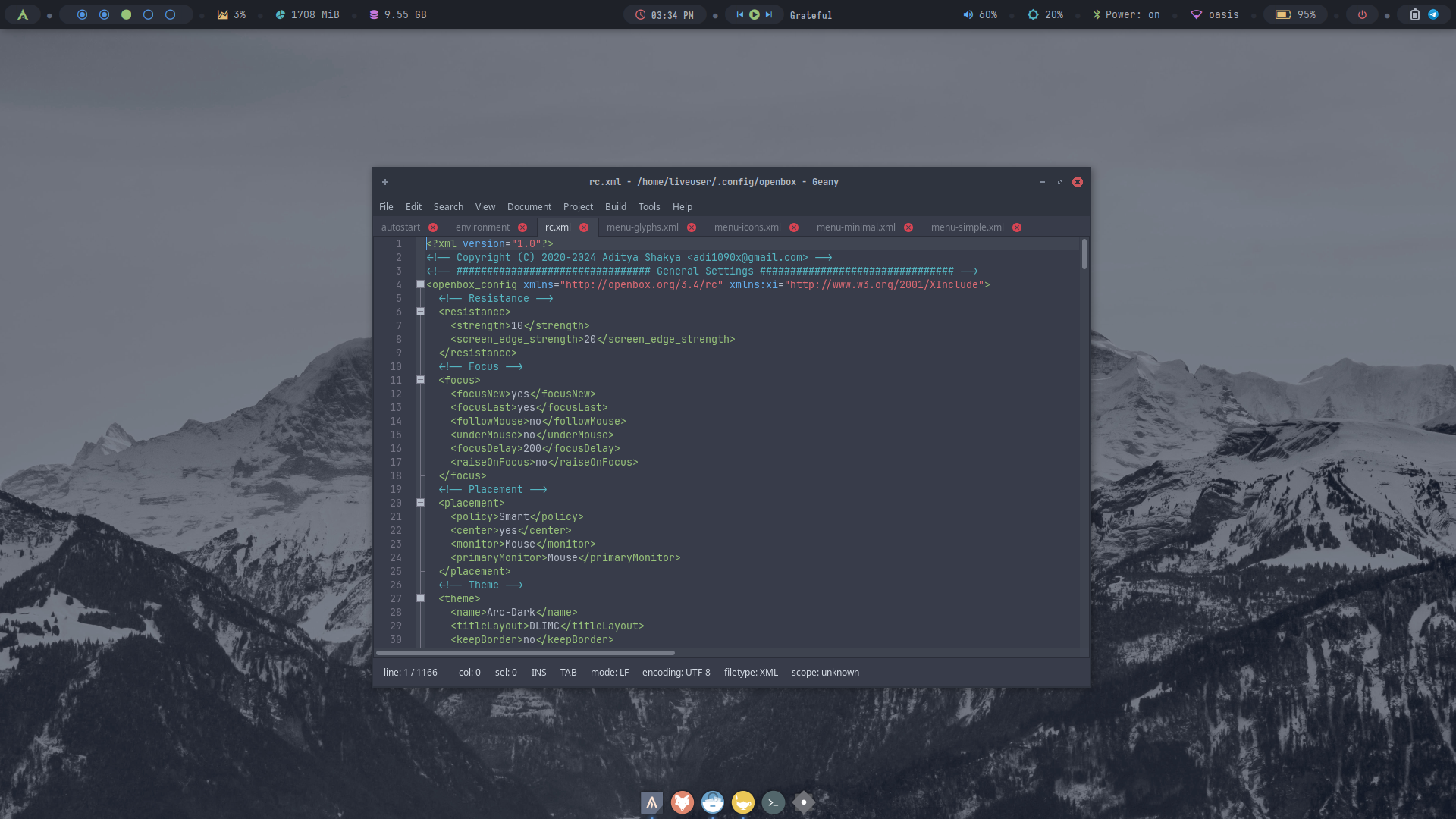 | 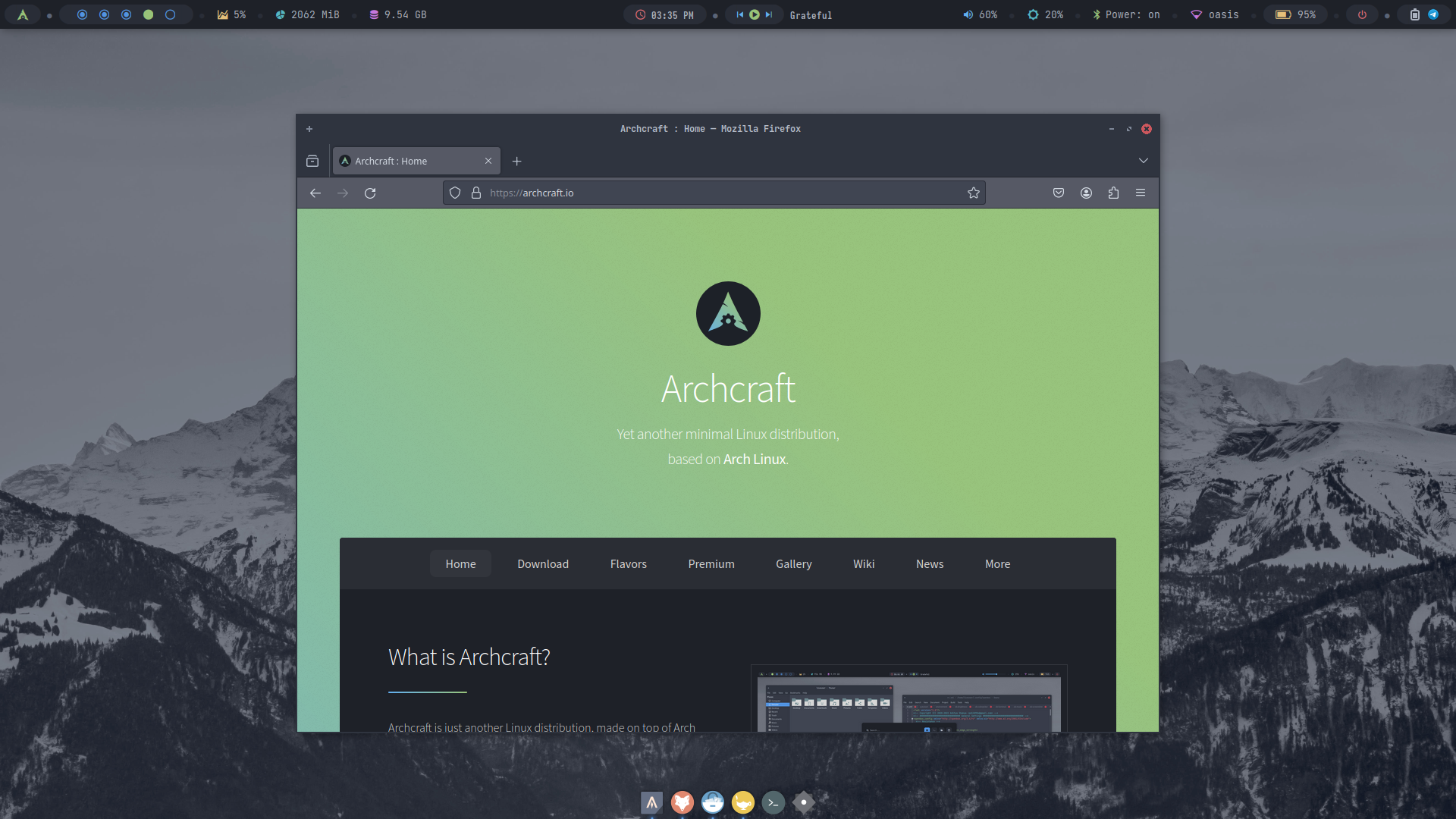 |  |
| Desktop 7 | Desktop 8 | Desktop 9 | Desktop 10 | Desktop 11 | Desktop 12 |
|---|---|---|---|---|---|
 |  |  |  | 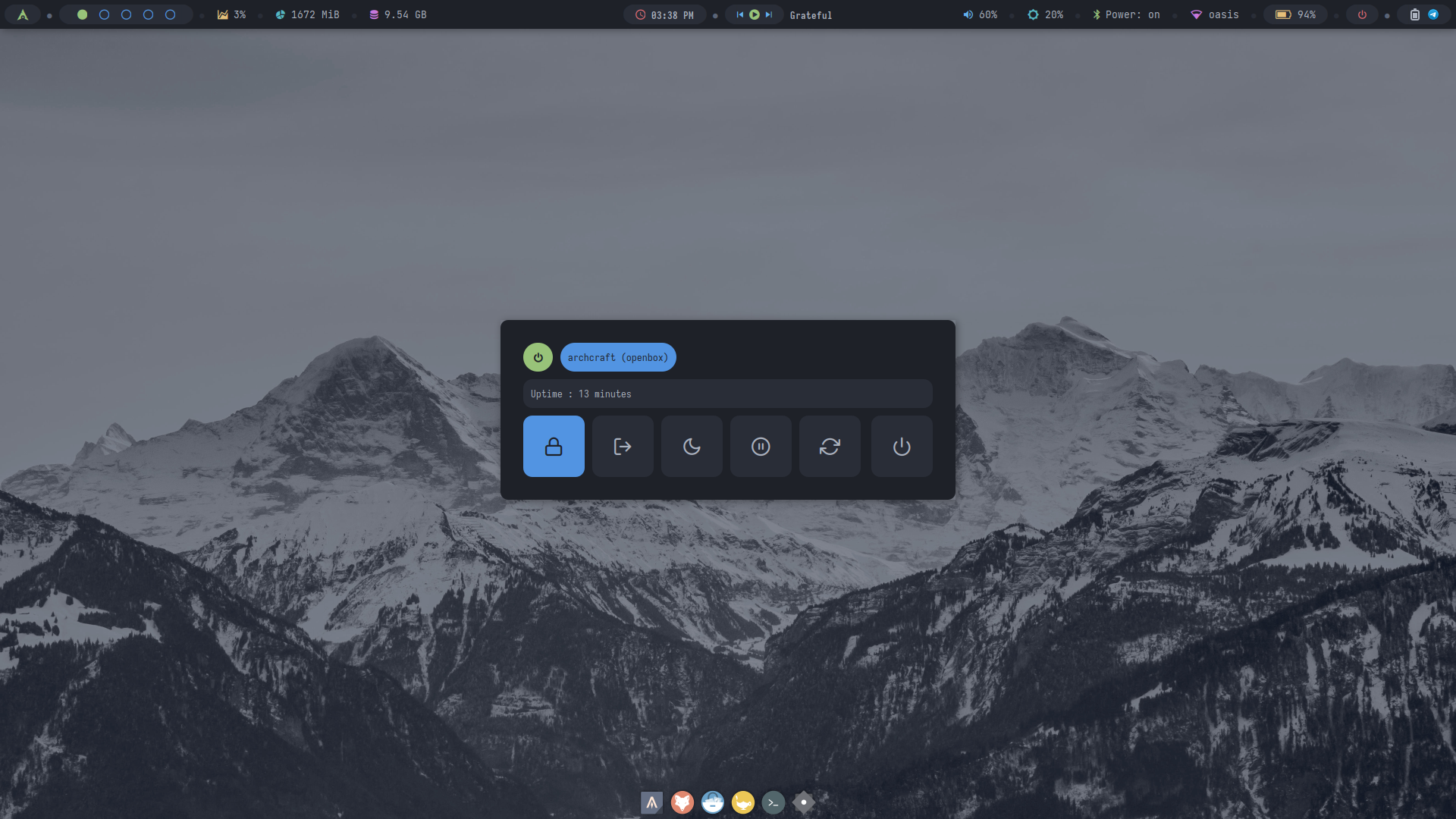 |  |
Themes
To Change the theme/style, Right click on the desktop and go to Preferences > Change Style
- Regular
- Premium
- Random
There are 10 styles available in regular Openbox.
| Theme 1 | Theme 2 | Theme 3 | Theme 4 | Theme 5 |
|---|---|---|---|---|
 |  |  |  |  |
| Theme 6 | Theme 7 | Theme 8 | Theme 9 | Theme 10 |
|---|---|---|---|---|
 |  | 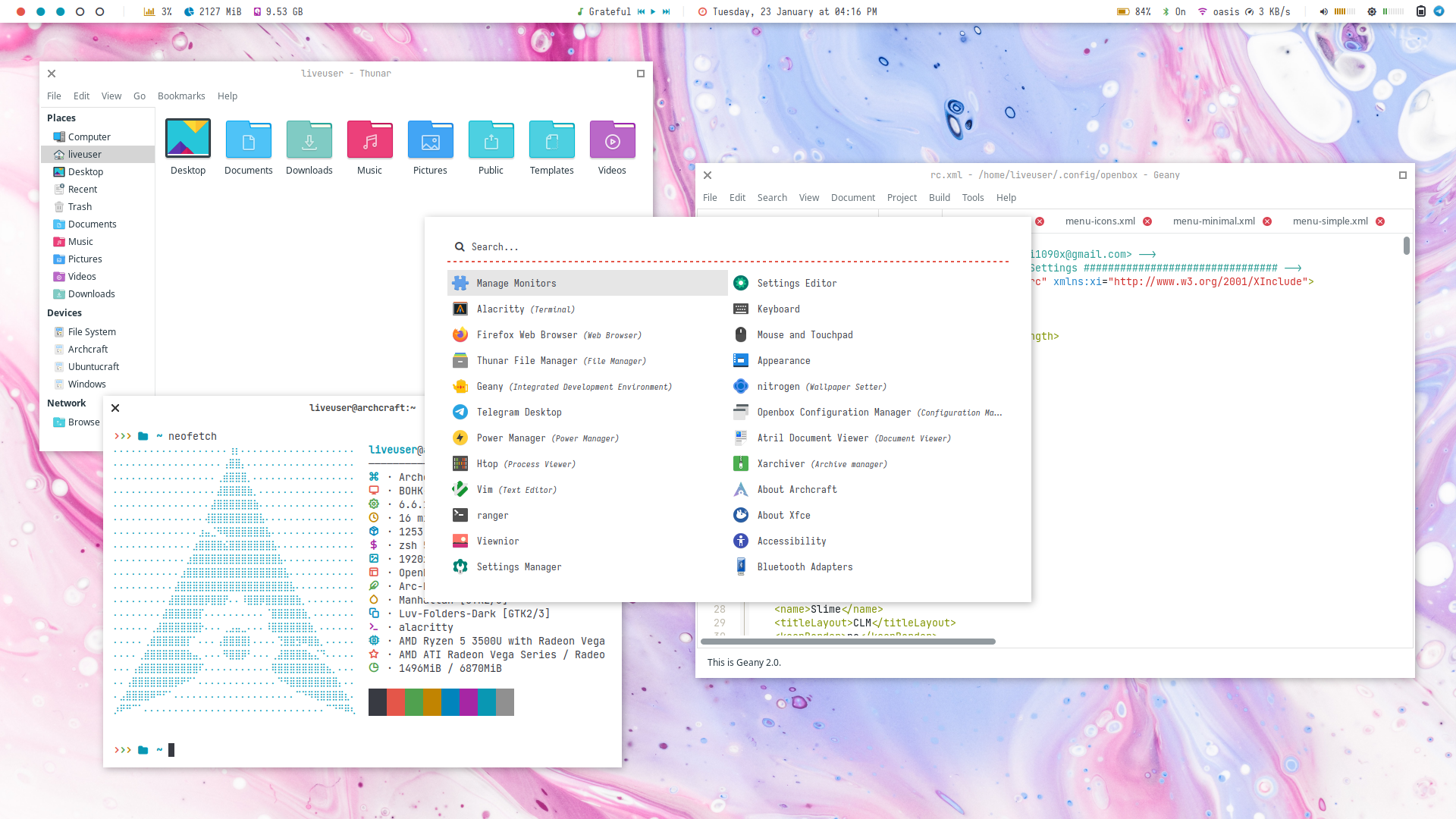 |  |  |
There are 25 styles (plus infinite auto-generated themes with pywal) available for Openbox premium.
| Theme 1 | Theme 2 | Theme 3 | Theme 4 | Theme 5 |
|---|---|---|---|---|
 |  |  | 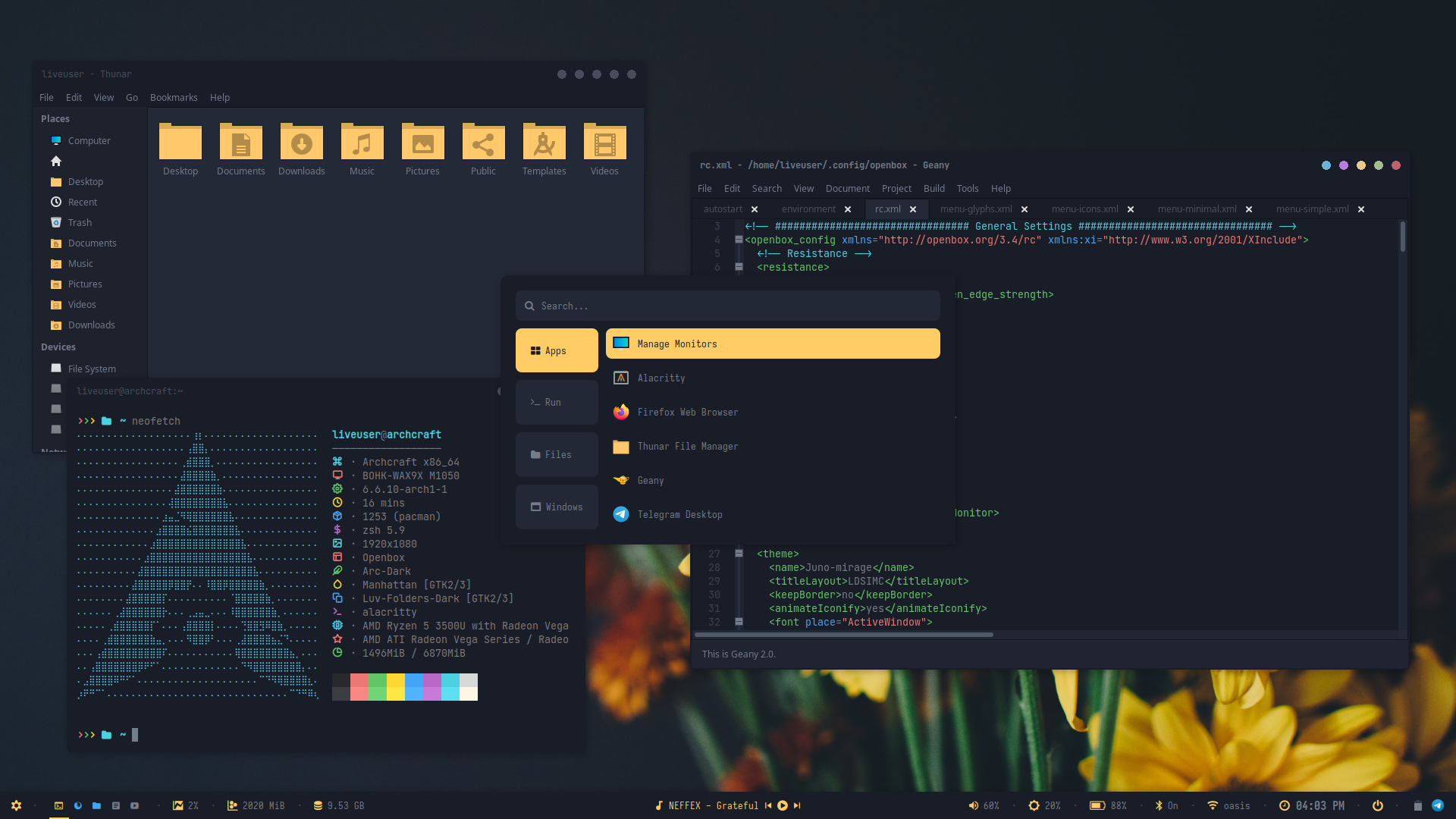 |  |
| Theme 6 | Theme 7 | Theme 8 | Theme 9 | Theme 10 |
|---|---|---|---|---|
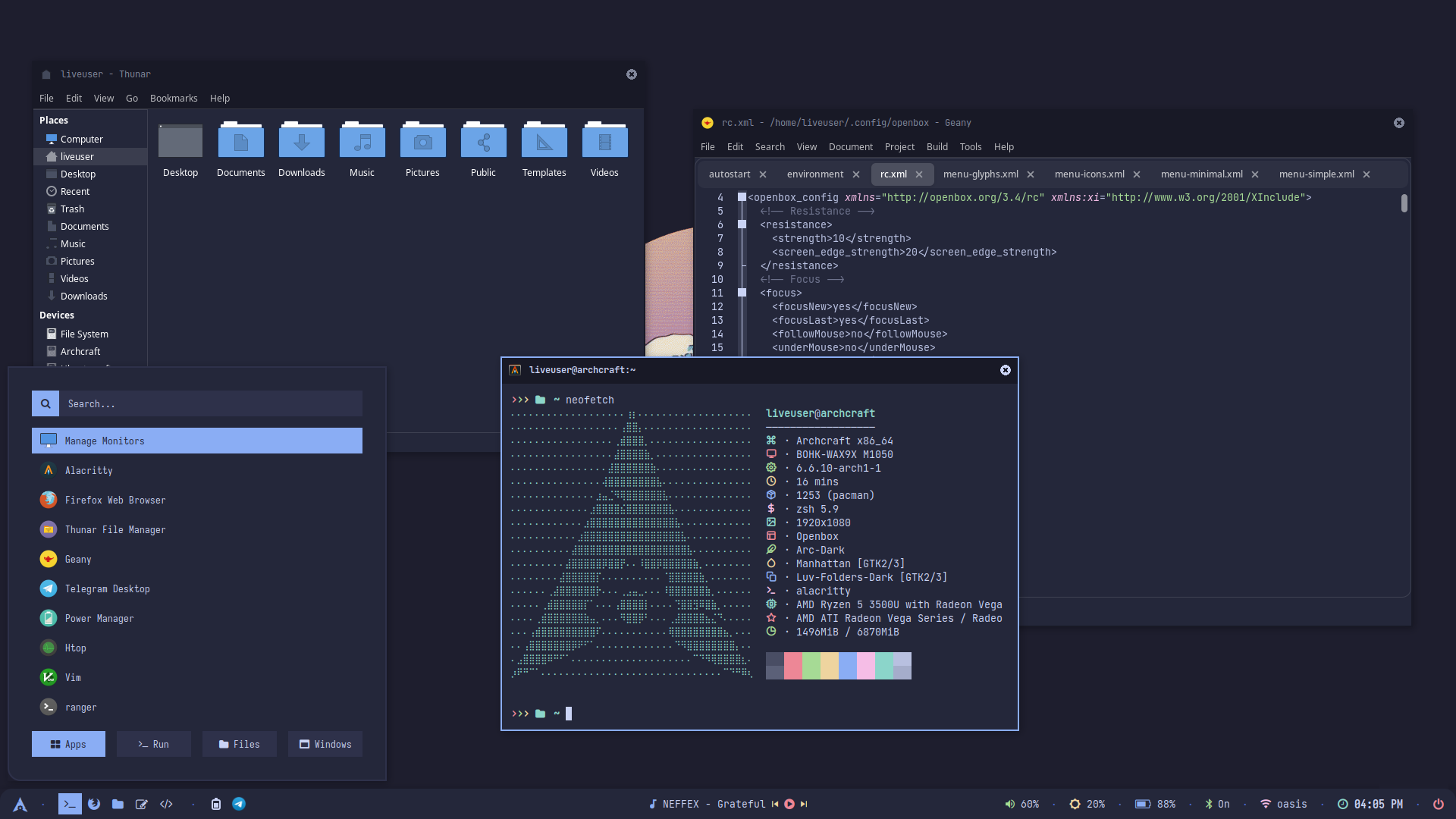 |  |  |  |  |
| Theme 11 | Theme 12 | Theme 13 | Theme 14 | Theme 15 |
|---|---|---|---|---|
 |  |  |  |  |
| Theme 16 | Theme 17 | Theme 18 | Theme 19 | Theme 20 |
|---|---|---|---|---|
 |  |  |  |  |
| Theme 21 | Theme 22 | Theme 23 | Theme 24 | Theme 25 |
|---|---|---|---|---|
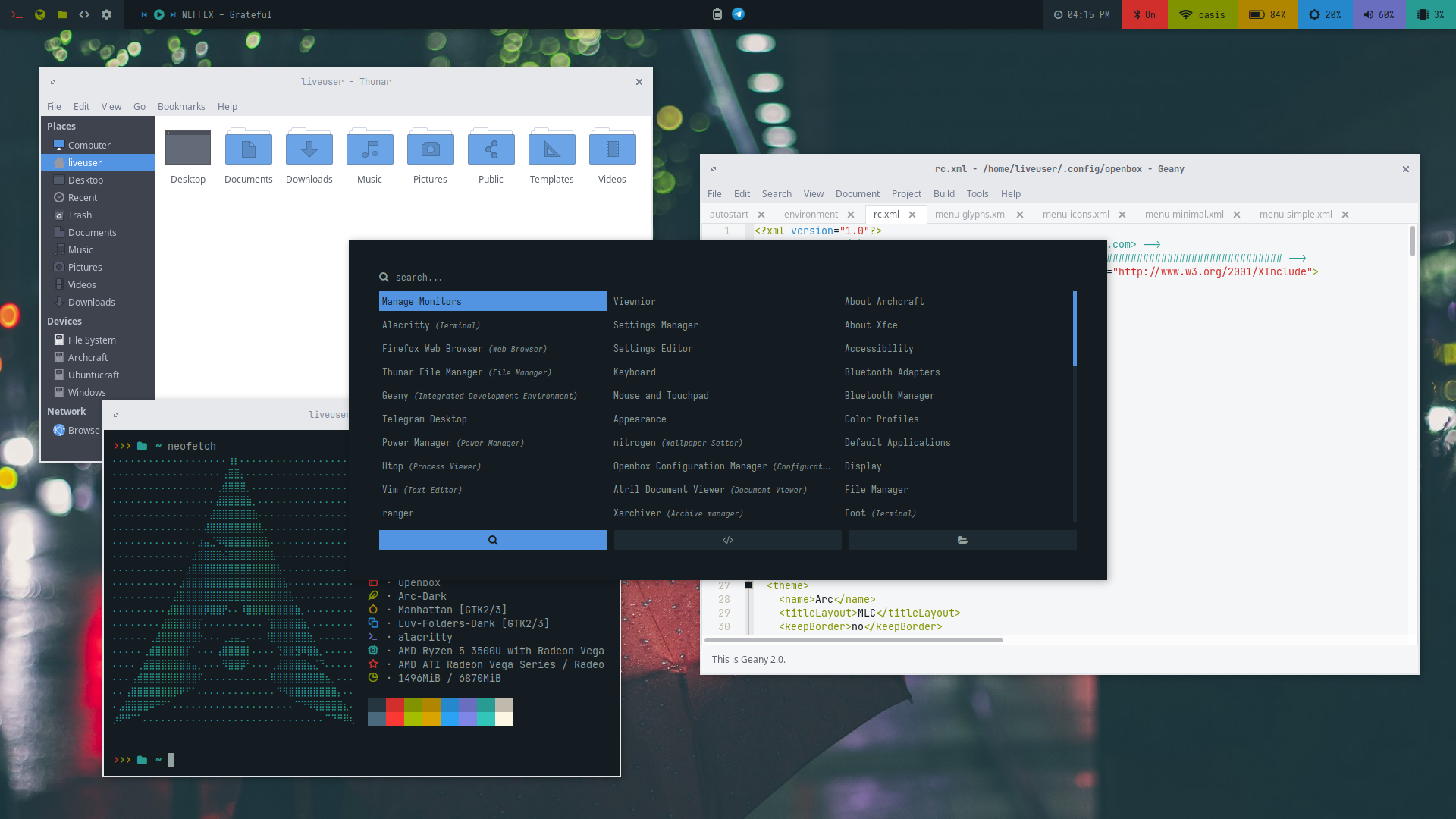 |  |  |  |  |
Auto Generated themes with pywal. This feature is only available in Openbox premium.
Go to Preferences > Change Style > Current and click on ✤ Change Colors to apply a random theme.

FAQs
How to update my config to new configs?
When a new version of Archcraft Openbox get released, And you update the system by sudo pacman -Syu or you update the Openbox package by sudo pacman -S archcraft-openbox, New config files get installed as openbox_pacnew_YYYY-MM-DD in your ~/.config directory.
To use new configs, backup your old ~/.config/openbox directory and move ~/.config/openbox_pacnew_YYYY-MM-DD to ~/.config/openbox and login again.
For
Openbox Premium, download the updated package from ko-fi (for free) and just install it to update to new configs.
How to open apps as root in openbox?
To open apps as root, Go to openbox menu Apps As Root, select the app and type your root password to open the app.
How to change desktop theme in openbox?
To change desktop theme, Go to openbox menu Preferences > Change Style and select the theme you want to use.
How to change GTK theme, icons and cursor?
To change GTK theme, icons and fonts in Openbox session, use xfce4-appearance-settings application.
You can open this app either via openbox menu Preferences > Appearance Settings or type Appearance in app launcher.
To change the openbox theme, use obconf app.
You can open this app either via openbox menu Preferences > Openbox > Settings or type obconf in app launcher.
How to manage multiple monitors and resolution in Openbox?
If you use multiple monitors with Openbox window manager, you can manage them via two methods :
- Run
launcherand type either Manager Monitors or archcraft-randr and use the app. - Go to openbox menu
Preferences > Display / Monitorand use the menu.
Why Alacritty is not working on my computer?
Since Alacritty is a OpenGL based terminal emulator, It may not work on some computer hardwares. You can make it work on such computers by following these methods :
- Open alacritty with LIBGL_ALWAYS_SOFTWARE=1 variable. Edit the keybindings/script launching alacritty and replace
alacrittywithLIBGL_ALWAYS_SOFTWARE=1 alacritty - Edit /usr/share/applications/Alacritty.desktop desktop file and replace
Exec=alacrittywithExec=env LIBGL_ALWAYS_SOFTWARE=1 alacritty
